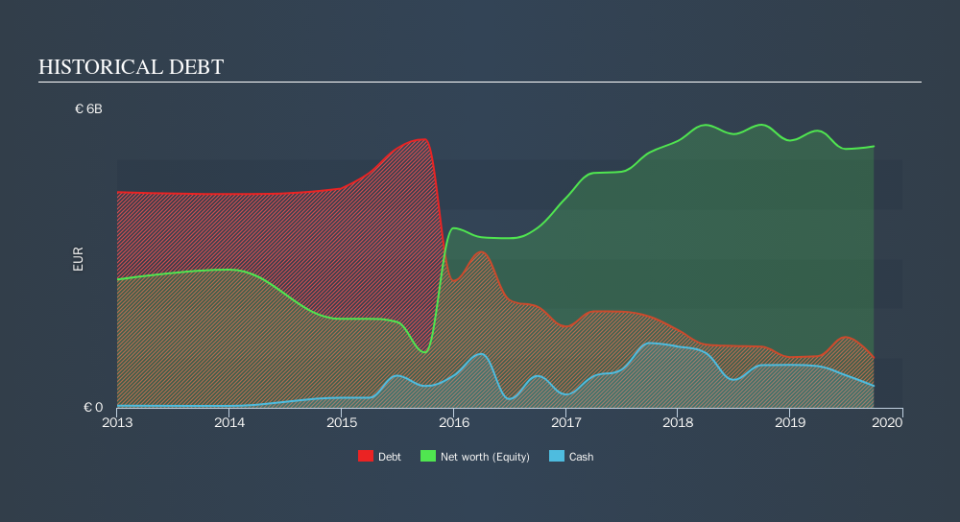Does Covestro (ETR:1COV) Have A Healthy Balance Sheet?

Some say volatility, rather than debt, is the best way to think about risk as an investor, but Warren Buffett famously said that 'Volatility is far from synonymous with risk. So it might be obvious that you need to consider debt, when you think about how risky any given stock is, because too much debt can sink a company. Importantly, Covestro AG (ETR:1COV) does carry debt. But the more important question is: how much risk is that debt creating?
When Is Debt A Problem?
Debt and other liabilities become risky for a business when it cannot easily fulfill those obligations, either with free cash flow or by raising capital at an attractive price. If things get really bad, the lenders can take control of the business. While that is not too common, we often do see indebted companies permanently diluting shareholders because lenders force them to raise capital at a distressed price. Of course, the upside of debt is that it often represents cheap capital, especially when it replaces dilution in a company with the ability to reinvest at high rates of return. When we think about a company's use of debt, we first look at cash and debt together.
Check out our latest analysis for Covestro
How Much Debt Does Covestro Carry?
As you can see below, Covestro had €981.0m of debt at September 2019, down from €1.23b a year prior. However, because it has a cash reserve of €441.0m, its net debt is less, at about €540.0m.
How Strong Is Covestro's Balance Sheet?
According to the last reported balance sheet, Covestro had liabilities of €2.11b due within 12 months, and liabilities of €4.25b due beyond 12 months. Offsetting these obligations, it had cash of €441.0m as well as receivables valued at €2.20b due within 12 months. So it has liabilities totalling €3.72b more than its cash and near-term receivables, combined.
This deficit isn't so bad because Covestro is worth €8.13b, and thus could probably raise enough capital to shore up its balance sheet, if the need arose. But we definitely want to keep our eyes open to indications that its debt is bringing too much risk.
We use two main ratios to inform us about debt levels relative to earnings. The first is net debt divided by earnings before interest, tax, depreciation, and amortization (EBITDA), while the second is how many times its earnings before interest and tax (EBIT) covers its interest expense (or its interest cover, for short). This way, we consider both the absolute quantum of the debt, as well as the interest rates paid on it.
Covestro's net debt is only 0.34 times its EBITDA. And its EBIT easily covers its interest expense, being 15.9 times the size. So you could argue it is no more threatened by its debt than an elephant is by a mouse. It is just as well that Covestro's load is not too heavy, because its EBIT was down 75% over the last year. When it comes to paying off debt, falling earnings are no more useful than sugary sodas are for your health. When analysing debt levels, the balance sheet is the obvious place to start. But ultimately the future profitability of the business will decide if Covestro can strengthen its balance sheet over time. So if you're focused on the future you can check out this free report showing analyst profit forecasts.
Finally, a company can only pay off debt with cold hard cash, not accounting profits. So the logical step is to look at the proportion of that EBIT that is matched by actual free cash flow. During the last three years, Covestro produced sturdy free cash flow equating to 67% of its EBIT, about what we'd expect. This cold hard cash means it can reduce its debt when it wants to.
Our View
Covestro's EBIT growth rate was a real negative on this analysis, although the other factors we considered were considerably better In particular, we are dazzled with its interest cover. When we consider all the factors mentioned above, we do feel a bit cautious about Covestro's use of debt. While we appreciate debt can enhance returns on equity, we'd suggest that shareholders keep close watch on its debt levels, lest they increase. Another positive for shareholders is that it pays dividends. So if you like receiving those dividend payments, check Covestro's dividend history, without delay!
Of course, if you're the type of investor who prefers buying stocks without the burden of debt, then don't hesitate to discover our exclusive list of net cash growth stocks, today.
We aim to bring you long-term focused research analysis driven by fundamental data. Note that our analysis may not factor in the latest price-sensitive company announcements or qualitative material.
If you spot an error that warrants correction, please contact the editor at editorial-team@simplywallst.com. This article by Simply Wall St is general in nature. It does not constitute a recommendation to buy or sell any stock, and does not take account of your objectives, or your financial situation. Simply Wall St has no position in the stocks mentioned. Thank you for reading.

 Yahoo Finance
Yahoo Finance 
